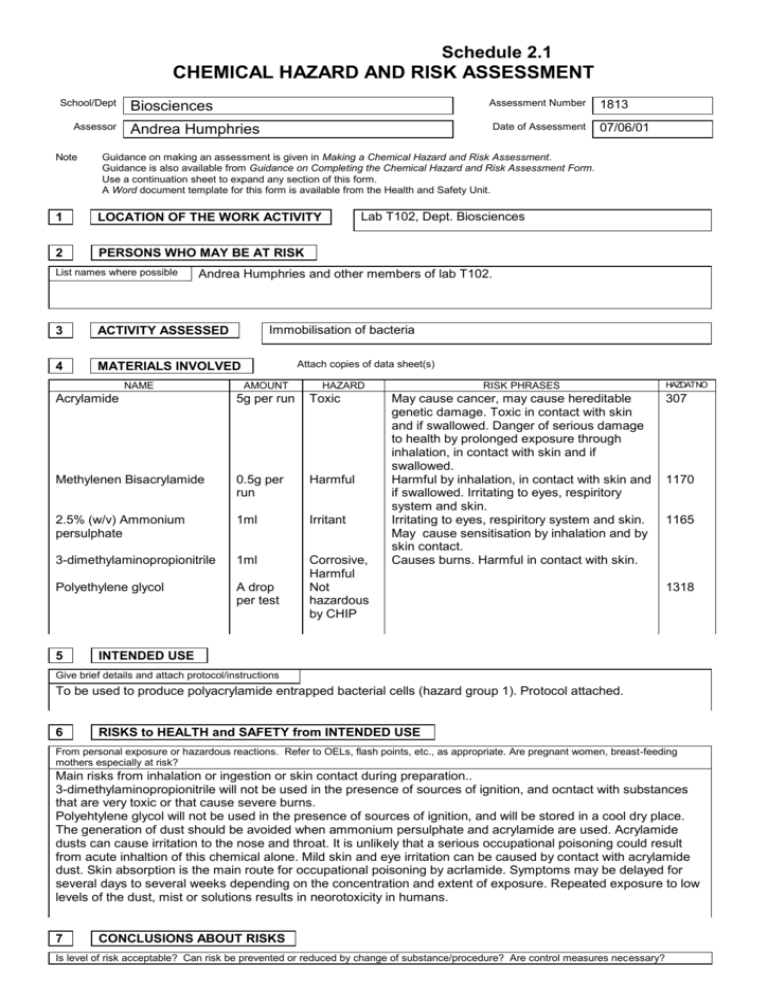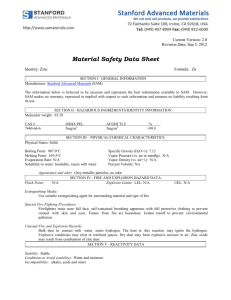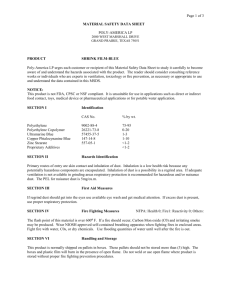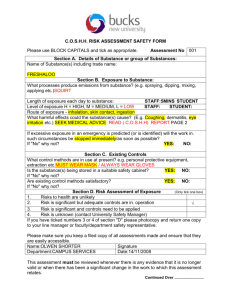1813 - Academic lab pages
advertisement

RISK PHRASES May cause cancer, may cause hereditable genetic damage. Toxic in contact with skin and if swallowed. Danger of serious damage to health by prolonged exposure through inhalation, in contact with skin and if swallowed. Harmful by inhalation, in contact with skin and if swallowed. Irritating to eyes, respiritory system and skin. Irritating to eyes, respiritory system and skin. May cause sensitisation by inhalation and by skin contact. Schedule 2.1 CHEMICAL HAZARD AND RISK ASSESSMENT School/Dept Assessor Note Assessment Number Biosciences Date of Assessment Andrea Humphries 07/06/01 Guidance on making an assessment is given in Making a Chemical Hazard and Risk Assessment. Guidance is also available from Guidance on Completing the Chemical Hazard and Risk Assessment Form. Use a continuation sheet to expand any section of this form. A Word document template for this form is available from the Health and Safety Unit. 1 LOCATION OF THE WORK ACTIVITY 2 PERSONS WHO MAY BE AT RISK List names where possible Lab T102, Dept. Biosciences Andrea Humphries and other members of lab T102. Immobilisation of bacteria 3 ACTIVITY ASSESSED 4 MATERIALS INVOLVED NAME Attach copies of data sheet(s) AMOUNT HAZARD Acrylamide 5g per run Toxic Methylenen Bisacrylamide 0.5g per run Harmful 2.5% (w/v) Ammonium persulphate 1ml Irritant 3-dimethylaminopropionitrile 1ml Polyethylene glycol A drop per test Corrosive, Harmful Not hazardous by CHIP 5 1813 RISK PHRASES May cause cancer, may cause hereditable genetic damage. Toxic in contact with skin and if swallowed. Danger of serious damage to health by prolonged exposure through inhalation, in contact with skin and if swallowed. Harmful by inhalation, in contact with skin and if swallowed. Irritating to eyes, respiritory system and skin. Irritating to eyes, respiritory system and skin. May cause sensitisation by inhalation and by skin contact. Causes burns. Harmful in contact with skin. HAZDATNO 307 1170 1165 1318 INTENDED USE Give brief details and attach protocol/instructions To be used to produce polyacrylamide entrapped bacterial cells (hazard group 1). Protocol attached. 6 RISKS to HEALTH and SAFETY from INTENDED USE From personal exposure or hazardous reactions. Refer to OELs, flash points, etc., as appropriate. Are pregnant women, breast-feeding mothers especially at risk? Main risks from inhalation or ingestion or skin contact during preparation.. 3-dimethylaminopropionitrile will not be used in the presence of sources of ignition, and ocntact with substances that are very toxic or that cause severe burns. Polyehtylene glycol will not be used in the presence of sources of ignition, and will be stored in a cool dry place. The generation of dust should be avoided when ammonium persulphate and acrylamide are used. Acrylamide dusts can cause irritation to the nose and throat. It is unlikely that a serious occupational poisoning could result from acute inhaltion of this chemical alone. Mild skin and eye irritation can be caused by contact with acrylamide dust. Skin absorption is the main route for occupational poisoning by acrlamide. Symptoms may be delayed for several days to several weeks depending on the concentration and extent of exposure. Repeated exposure to low levels of the dust, mist or solutions results in neorotoxicity in humans. 7 CONCLUSIONS ABOUT RISKS Is level of risk acceptable? Can risk be prevented or reduced by change of substance/procedure? Are control measures necessary? The amount of chemcials used is low, thus reducing the risk. Acceptable level of risk. 8 CONTROL MEASURES Additional to Good Chemical Practice Acrlamide: The generation of dust will be avoided. Use procedures and experimental equipment that will precent personel contact with the substance. Wear appropriate personel protective equipment to deal with any residual risk. This chemical will be stored in a cool, dry place. A half mask will be used to void iinhalation of dust. Appropriate gloves will be worn when handling acrlamide (tpe/EVAL/PE gloves). Ammonium persulphate and methylenebisacrlamide: The generation of dust will be avoided. Contact of this chemical with substances that are highly flammable will be avoided. A half mask will be worn to avoid inhaltion of dust. Appropriate gloves will be worn when handling these chemicals. Polyethylene glycol: Half mask will be worn to avoid inhaltion of dust. 3-dumethylaminopropionitrile: Treat empty containers as fire/ explosion hazard. 9 INSTRUCTION/TRAINING Specify course(s) and/or special arrangements. None 10 MONITORING Performance of control measures, N/A Personal exposure Health Surveillance N/A N/A 11 WASTE DISPOSAL PROCEDURE .Acrylamide: Dipose of as 'special waste' using arrangements set out in 'hazardous substances policy'. Ammonium persulphate: Add a little at a time, with stirring to an excess of water. Polyethylene glycol: Add a little at a time, with stirring to an excess of water. 3-diaminopropionitrile: Add a little at a time, with stirring to an excess of water. Methylene bisacrylamide: Add a little at a time, with stirring to an excess of water. 12 REVIEW Enter the date or circumstances for review of assessment (maximum review interval 5 years) 5 years or if procedures change significantly. 13 EMERGENCY ACTION TO CONTROL HAZARDS To stabilize situation eg spread absorbant on liquid spill; eliminate sources of ignition, etc. Wear protective equipment. Avoid raising dust. Acrylamide: Prevent material entering drains and water courses in event of a spill. Transfer leak to a suitable labelled container if safe to do so. Use a vacuum cleaner equpiied with a HEPA filter to clean up dust. or dampen spilled material with water. Scoop up spill and place in a lebelled container. Thouroughly wash contaminated area with plenty of water Ammonium persulphate/ Polyethylene glycol/ 3-dimethylaminopropionitrile: Prevent material entering drains and water courses. Stop or reduce leak if safe to do so. Avoid generating dust, use a vacuum cleaner equiped with a HEPA filter to clean up dust, or dampen spilled material with water. Scoop up spill and place in a labelled container. TO PROTECT PERSONNEL Evacuation, protection for personnel involved in clean-up, Special First Aid Skin contact: drench affected area with clean running water and wash with soap for at least 10 minutes until no chemical remains in contact with the skin. Eye contact: Flush eye with clean running water for at least 10 minutes. Obtain medical exam of affected eye. Ingestion: Do not make the casualty vomit. Wash out mouth with water. I Inhalation: Remove casualty from exposure. Rest and keep warm. Obtain medical attention if casualty has been unconcious. TO RENDER SITE OF EMERGENCY SAFE Clean-up/decontamination 14 EMERGENCY CONTACT NAME L.E. Macaskie PHONE Schedule 2.1 Guidance on Completing the Chemical Hazard and Risk Assessment Form 1 Location of the Work Activity The location of an activity can significantly alter risk. Different levels of risk may arise from the same activity performed in different locations if there is also a difference in the standards of facilities of the locations. 2 Persons Who May be at Risk In some cases individuals will be named in this section. In other cases it will be more appropriate to refer to groups of people such as cleaning staff, an undergraduate class. 3 Activity Assessed Identify the activity by an appropriate title. 4 Materials Involved Identify a product by its proprietary name followed by a listing of the constituent chemicals. In the "Amount" column specifiy the quantity of substance used and or concentration. The "Hazard" is the word(s), such as "Oxidizing" or "Toxic", associated with the hazard warning symbol(s) and "Risk Phrases" is the further details of the nature of the risk, such as "Toxic by inhalation", which appear on the container label. Specify the data sheet number from the University's UNICOSHH chemical hazards database. Attach copies of data sheets to the assessment form. 5 Intended Use Describe the activity in outline, but include details such as quantities, durations, etc. which will assist in the assessment of risk. If the activity follows an official, approved or standard procedure or undergraduate course script, etc. cite references and attach copies of protocols/procedures to the assessment form. 6 Risks to Health and Safety from Intended Use List here only the harmful or hazardous effects that could arise from the intended use. Also note factors such as quantity, physical properties (e.g., evaporation rate), exposure limits, vapour concentrations, flash points, toxicity data, etc. which will influence the conclusions made about the risks that may arise from the activity and from foreseeable emergencies. Are pregnant women, breastfeeding mothers especially at risk? 7 Conclusions About Risks Is the level of risk acceptable? Can any risks be eliminated or reduced by not using a particular substance or procedure or by substituting lower risk alternatives? Are further controls necessary? The HSE require sufficient detail to be recorded for it to be clear how conclusions about risk were arrived at. 8 Control Measures List measures such as working practice, enclosed equipment, fume cupboard, personal protective equipment, prohibitions on sources of ignition, etc., which are not detailed in section 4. Where appropriate, specify class of equipment, type of material, level of performance, etc. (see Hazardous Substances Policy Schedule 3) If measures are entirely in accordance with requirements in Schedule 3, then simply specify the schedule number. 9 Instruction/Training Specify a Health and Safety Unit course or any other course or special arrangements. 10 Monitoring "Performance of Control Measures" Specify the testing that will be required and its frequency. (see Hazardous Substances Policy Schedule 3) Schedule 2.1 "Personal Exposure" If the work will cause people to be exposed to a substance, and either it is not known whether the exposure will be excessive or exposure is expected to be close to the limit, personal monitoring must be specified The type and frequency of monitoring should be specified. "Health Surveillance" Some form of health surveillance is mandatory for specified activities or work with certain substances and if it is believed likely that exposure may give rise to observable health effects (See Hazardous Substances Policy Schedule 4). Relevant examples of substances for which health surveillance is required: Substances of recognised systemic toxicity (e.g. carcinogens, substances labelled "may cause cancer" or "may cause cancer by inhalation" (see Hazardous Substances Policy Schedule 3.3 for further identification of carcinogens) or heavy metals such as lead, cadmium) Substances labelled "May cause sensitisation by inhalation" and other substances known to cause occupational asthma Substances labelled "May cause sensitisation by skin contact" and other substances known to cause severe dermatitis. Soldering using rosin flux Many of these substances are identified in the University's UNICOSHH database. Details should be given of appropriate Health Surveillance after consultation with The University's Occupational Health Physician. 11 Waste Disposal Procedure Give details, or refer to approved procedure (see Hazardous Substances Policy Schedule 7), such as the University's Special Waste (identify the category) disposal arrangements, if appropriate. 12 Review Specify the foreseeable event, change of circumstances, change of substance, that could invalidate the original assessment and give cause for review. The maximum review interval is 5 years. 13 Emergency Action The details given here must be compatible with the department's emergency plan. The appropriate persons must be notified if the effects of a potential incident are likely to spread beyond the laboratory and/or building. g:\aww7text\uhsp\hs15\hs2assfm.doc 10.5.00







